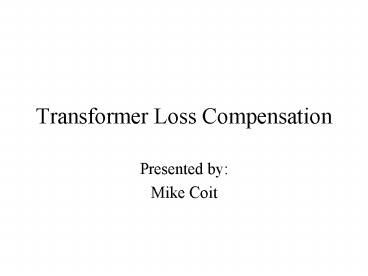Transformer Loss Compensation - PowerPoint PPT Presentation
1 / 10
Title:
Transformer Loss Compensation
Description:
Transformer Loss Compensation Presented by: Mike Coit Why Use TLC? Billing point is different than metering point. Impractical to meter at billing point. – PowerPoint PPT presentation
Number of Views:210
Avg rating:3.0/5.0
Title: Transformer Loss Compensation
1
Transformer Loss Compensation
- Presented by
- Mike Coit
2
Why Use TLC?
- Billing point is different than metering point.
- Impractical to meter at billing point.
- Too expensive (High Voltage vs. Low Voltage).
- Inaccessible.
- Low voltage service changed to high voltage
service, existing metering to be used.
3
TLC Objectives
- Determine unmetered losses between billing point
and metering point. - Add (subtract) the unmetered losses to (from) the
metered quantities. - Energy (kWh) and Quadergy (kvarh) may both be
compensated for at the metering point.
4
Loss Compensation Methods
- Transformer Loss Meter
- A separate meter with special V2 and I2 stators
- Transformer Loss Compensator
- Losses added into standard watthour meter
registration using a specialized compensator. - Resistor Method
- A variation of above, using resistors for no-load
compensation and calibration adjustments for load
loss compensation. - Solid State Meter with TLC capabilities
5
Transformer Losses
- Hysteresis (no-load loss)
- Energy expended from changing intensity and
direction of magnetic flux in transformer. - Eddy Currents (no-load loss)
- Energy expended by circulating currents induced
within the core material - Load Currents (load loss)
- Energy expended by load current in transformer
windings having some resistance (I2R losses). - Treat Line Loss compensation (if needed) as if
its part of transformer load losses.
6
Transformer Loss Modeling
- No-load loss watts proportional to V2
- Load loss watts proportional to I2
- No-load loss vars proportional to V4
- Load loss vars proportional to I2
- Manufactures supply watts loss test results
- Loss vars are derived from the mfg. data.
7
Data required for kV2 TLC
- Rated kVA
- L-N Voltage
- Line Current
- VTR
- CTR
- No load loss watts (Iron Losses)
- Load loss watts (Copper Losses)
- Excitation Current
- Impedance
- Line Losses (optional)
Per element values
8
TLC Values calculated for kV2
- Secondary Conductance, G
- G Elem (LFE Elem watts VTR / CTR) / (Volts
L-N)2 - Secondary Resistance, R
- R Elem ((LCU Elem watts LL Elem watts) CTR /
VTR) / (Amps Line)2 - Secondary Susceptance, B
- B Elem (LFE Elem vars (VTR)3 / CTR) / (Volts
L-N)4 - Secondary Reactance, X
- X Elem (LCU Elem vars CTR / VTR) / (Amps
Line)2
9
How TLC is performed in the kV2
- Every momentary interval
- Per element losses are calculated
- Example LFE Elem wh G Elem VL-N2h
- Losses are added to or subtracted from load
measurements - Adjusted values are then processed normally
(energy and quadergy is accumulated, demands are
calculated, etc.)
10
Testing a TLC enabled kV2
- Calibration LED is unaffected by TLC
- TLC may be disabled to facilitate testing using
displayed values or PI outputs - Check no load losses by applying expected voltage
only (no current) to the meter - Note that expected voltage may differ from
typical test voltages - Load losses can be compared after subtracting out
the measured load and no-load losses from the
metered value.































